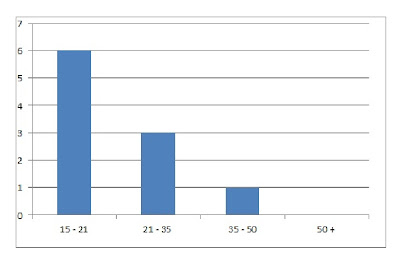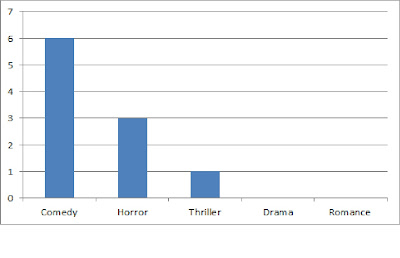GS20 Foundation Portfolio 2011
Friday, 8 April 2011
Monday, 4 April 2011
In what ways does your media product use, develop or challenge forms and conventions of real media products?
It was important to us, as a group, that our thriller was different from previous attempts by other students and even big-time media productions. We saw that in other productions people tried to give too much away and tell a lot of the story in the 2 minutes, however by definition a Thriller should be suspenseful and this cannot be created by being explicit in the opening so instead we opted to only give the audience small clips and shots in the opening sequence to make them ask questions and get them thinking about the connotations of the images.
Inspiration we took from other openings include: Seven (David Fincher, 1995) which is featured heavily throughout our initial research into other thrillers. Seven is shot in an extremely clever way as to give nothing away to audience with its use of angles and the way it changes focus from background and foreground depending on what the Director would like the audience to see leaving the audience with questions about the sinister images they have been shown and giving them implications, subliminally about the rest of the film.
Another film we drew inspiration from was the credits from The Collector (Marcus Dunstan, 2009). The sounds used were very effective at creating tension by building up a beat; steadily increasing the tempo to give the effect of a heart beat getting faster. This again used short clips of shocking images to grab the audience’s attention, similarly to Seven.
How does your media product represent particular social groups?
Like many thrillers ours is set in an ‘every-day’ environment which is used to give the audience a false sense of security. Ours particularly focuses on middle class suburbia and how it is made to seem safe but with the fall of darkness come hidden dangers. Our product represents middle class, nuclear families, as many thrillers do, as victims. This is because most audience find it easy to feel sympathetic towards an innocent family.
What kind of media institution might distribute your media product and why?
A company that might distribute our film is Lionsgate as they have distributed many films in the thriller/horror genre including American Psycho, Saw, House of 1000 corpses and Hostel which are similar to our production. Lionsgate is the most commercially successful independent film and television Distribution Company in North America but although Lionsgate is a Canadian-American company they also have a British branch called Lions Gate UK.
Who would be the audience for your media product?
If our product were to be made into a full production I believe it would be given a 15 certificate by the BBFC this is because it is quite shocking and would not be suitable for children under this age and would possibly contain graphic images and violence. So our target audience would probably be people between the ages of 15 and late thirties. As with most psychological thrillers the audience would need a high attention span to keep up with the story line, this is again another reason why it may not be suitable for younger audiences.
What have you learnt about technologies from the process of constructing this product?
Before constructing this product I had no real previous experience using a camera or any editing software so all specific technologies used were new to me. I think that the preliminary task helped in getting used to the camera an example of a skill I learned straight away was setting the white balance so that every time we changed location or changed lighting the white balance would need to be altered to improve the quality of the colours in the shot because the camera needs to adjust to the different lighting. This production also gave us freedom to use a variety of shots because there was no specification of shots to be used like there was in the preliminary task. The most important thing I have learned is how much editing can affect the final product. Transitions played a big part in creating a fast paced tense effect in our product, fast cuts were used to create this effect but fades were also important when leaving an image lingering in the audiences mind.
Looking back at your preliminary task, what do you feel you have learnt in the progression from it to the full product?
I have come a long way since the preliminary task in terms of skills and experience. For instance controlling the camera, in the preliminary task I found it hard to control the speed of zooming, panning and titling but now have greater control over the camera which leads to an overall better quality of production. I also feel that everything in the preliminary task was quite basic for convenience sake such as location, cast and props; there was not as much thought behind the reasons for these things it was just an easy option, however much more thought went into the planning of the final production as the locations were chosen because they were relevant to the story such as the garage being chosen to create a tense, spooky atmosphere and the train station was used to replicate a shot that I had seen in other productions which I thought was effective in creating mystery in a character.
How did you attract/address your audience?
We attracted our audience by leaving them to ponder on the images we showed them, such as what does the teddy bear symbolise and who is the mysterious character? Although this is a convention of other thrillers we also attracted our audience by trying to do something different than other productions using a fast pace to create the tension and suspense as it builds up and the audience are disorientated, to an extent, with the shocking images.
Friday, 18 March 2011
Filming
The second location we used was the outside shot from the rear of my house. It was used for an establishing shot for the sequence and so needed to be one of the more effective shots to draw in the audience straight away. I held the camera for the shot and Jake turned off the light for the link to the next shot with a 15 second delay from the time the camera started rolling until the light turned off to make sure we had enough footage for the shot to be cut down to get a smooth transition when editing into the next shot.
Props:
Teddy Bear

The bear was used to represent the innocent of youth and to imply to the audience that the crimes our antagonist was committing were towards children. Audiences tend to feel more sympathetic towards children because they are seen to be defenceless and innocent.
Tools:
The tools were used to imply sadism and give an implicitly sinister feel to our production as there were several different shots in which different tools were used.
Leather Gloves:
Leather gloves have connotations of crime because they're often used in crimes to help people keep their identitiy hidden.
Risk Assessment
Risk | To Who/What | Prevention of Risk |
Loosing equipment | Camera , tripod, film | Make sure all equipment is accounted for before and after every filming session and locked away in media storage cupboard as soon as possible after filming is completed. |
Impaling/ being sliced by tools | All members of crew | Careful handling of props to make sure no injuries occur. |
Falling into train lines | All members of crew/equipment | Make sure no filming happens over the yellow lines on the train platforms. |
Weather damage of equipment | Camera, tripod, film | Don’t film in the rain or make sure the camera is covered well. |
Locations
Location 2: Outside of my house, Large house surrounded by lots of foliage which can give the impression that someone could be watching from the bushes with the right positioning of the camera.
Location 3: Attenborough train station, necessary for a shot in which a train drives by and a figure disappears from the other side of the tracks.
Location 1 updated: My Garage, similar reasons for the original location it was just more convenient to film there.
Actors
Internet Audience Research
Monday, 7 March 2011
Filming Schedule
| ||
| ||
Seven (David Fincher, 1995)
 The sequence opens with a shot of a book opening in the foreground, in the background there is an out of focus hand turning the pages. The hand is out of focus so that the character remains a mystery and so that the audience are unable to create a connection with the character. The credits also appear throughout the sequence with a blurry crooked font, in this shot “new line credits presents”.
The sequence opens with a shot of a book opening in the foreground, in the background there is an out of focus hand turning the pages. The hand is out of focus so that the character remains a mystery and so that the audience are unable to create a connection with the character. The credits also appear throughout the sequence with a blurry crooked font, in this shot “new line credits presents”. 
In between shots it cuts to a shot of a black background with credits in flickering to give a creepy effect. Fading to a shot of a picture of a pair of mangled hands, the picture looks like a photocopy, this again leaves the audience in confused as to what the image is actually of, as they don’t know who the hands belong to but it can be presumed that something unfortunate has happened to the owner of the hands.
After this shot there are a series of shots of the murderer preparing for something as he is checking tools and peeling his fingertips off with a razor blade which in itself is quite shocking and graphic for the audience to watch. But also shows that a sinister event is about to happen or will happen in the duration of the film.
This opening to this film is inspiring to my thriller because it doesn’t give too much of the story away which is what my aim is in this project because I know in past years when people have attempted this project they try to tell a whole story and give away too much in the first 2 minutes which tends to look rushed and not well thought out. I would like to set the scene and give the audience implications to what the film will be about which will keep the audience guessing which from my audience research I have found to be an aspect of the thriller genre people enjoy.
Friday, 4 March 2011
Results
Our sample was mainly in the ’15-21’ age category. This was mainly for convenience as it was easier to ask our peers to partake in the questionnaire.

How often do you watch films? :
This shows that the people we asked watched a film at least once a week if not every day. Also showing that they have some knowledge about film and are likely to watch many different genres.
What is your preferred genre? :

When watching a thriller what do you expect? :
The majority of people replied that they expected there to be many twists to keep them guessing, so it is useful to take that into account and live up to the expectations of the audience. However, only filming the first 2 minutes means that we can’t give away too much of the story.
How do thrillers make you feel? :

After you have seen a thriller does it make you think deeper into it?
This shows that people expect a huge twist at the end of the films with people making reference to ‘The Sixth Sense’ and ‘Shutter Island’.
The majority of people said that the diegetic sounds make more of an impact on them than actually being able to see a graphic shot.
Friday, 18 February 2011
The Thriller Genre
Sunday, 13 February 2011
Monday, 7 February 2011
Thriller Research
Researching several different thrillers was useful as it gave me inspiration and allowed me to identify the different conventions of a thriller. The first thriller I chose to research and analyse was 'Seven' (David Fincher, 1995). This opening is perfect as it is 2 minutes long and incorporates everything I will need to include in my opening sequence. As well as the opening credits to 'The Collector' (Marcus Dunstan, 2009) which is quite similar but I find the music shocking and keeps the tempo going as the drum beat represents the build up of the audience heart beat.
Tuesday, 1 February 2011
Friday, 28 January 2011
Editing
Editing was done using 'Adobe premier pro'. All the clips were put together to get the basic flow of the sequence as with some shots there were several different versions from slightly different angles.
Then each clip was cut down so the transitions of shots looked more natural whether it was a straight cut or fade to the next scene. The fades were used to create a time delay where characters moved to a different place in a shortened time such as moving from the toilet to outside:
Friday, 21 January 2011
Filming
We used Jake to act as the male character because he has previous acting experience from drama and was suitable for the character because he was similar age. After initially using Sophie as the female character we then decided to use someone from outside the group to act as the female character as she also had previous experience in acting.
The first location used was the toilet, as the toilet is quite a private area the character can be alone with his thoughts as he prepares to break up with his girlfriend, the audience can also see that he is nervous from his facial expression as he looks at himself in the mirror.
The next location used was the outside of the sixth from which is a long path to walk down. The long distance from the character shows that he feels lonely and distanced. The white balance also had to be changed because of the change of lighting in each location.
The hallway scene was used to create continuity as the character moves from one shot to the next, the audience only sees the characters shoes and legs as he makes the final walk towards the room where his girlfriend is waiting.
As the male character opens the door we see a mid shot from the outside of the room where the exchange will happen which then straight cuts to the inside of the room as the male character walks through to a close up on his face to see his nervous expression.
The exchange of dialogue between the two characters required three different shots; a two-shot of the dialogue, an over the shoulder shot from the male characters perspective and an over the shoulder shot from the female characters perspective. This is so that there can be an establishing shot and a shot reverse shot of the conversation.
Monday, 17 January 2011



 17/01/2011
17/01/2011Storyboards were drawn up to convey every shot that would be used and how they would cut or fade into each other. A storyboard is critical because it makes sure everyone knows what they are doing when filming including actors and the director. The original storyboard didn't include enough shots so as a group we decided to re-do it as there was not much time left in the lesson we had to cut down on detail.
Friday, 14 January 2011
Prelimanary task planning
Started by choosing a group to work with, the members of my group are Jake, who i have previously worked with. As well as Sophie and Emmie, who I have not worked with before. This is a good thing because it brings new and different skills and ideas as well as the safety of having someone I know I can rely on.
We then decided on the basis of our preliminary task, the three main ideas we had were: an interrogation, a break-up and a comical scene. We came to the decision of a break-up sequence because we would be able to convey a lot of emotion through the shots especially the close-up which is used throughout all genres of television and film to emphasize emotion. As well as the music which can change the mood of a sequence depending on the type of music.












